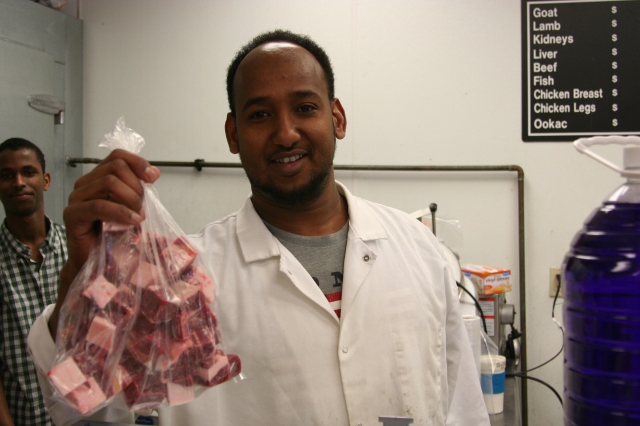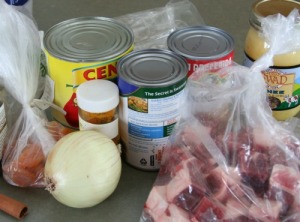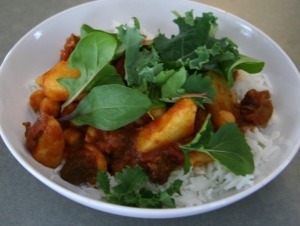 A week ago, when I went into St. Cloud Meat and Grocery, one of several Somali grocery stores in town, to buy some rice, there were a couple guys in the back of the store chopping meat. I asked what kind of meat they had, thinking if it was lamb I would buy some.
A week ago, when I went into St. Cloud Meat and Grocery, one of several Somali grocery stores in town, to buy some rice, there were a couple guys in the back of the store chopping meat. I asked what kind of meat they had, thinking if it was lamb I would buy some.
“Camel,” said the owner.
“Camel?”
He smiled. “Do you want to see it?” Well, of course I did. We went to the meat counter and he showed me the bags of chunky red meat, some of the chunks entirely fat. The boys were busily mincing up some other kind of meat.
How could I resist? I bought a little over a pound of camel stew meat. “What is it like?” I asked the man. “What other meat recipes should I look for?”
 “It’s like goat,” he said. After quickly considering and dispensing with the idea of the Bedouin wedding dish parodied in T.C. Boyle’s novel Water Music, whole stuffed camel, (good for when you have to feed 400 or so), I looked for something featuring African spices and went looking for African goat stews. I found this one on a blog called Jan’s Sushi Bar: www.janssushibar.com/moroccan–goat–stew/
“It’s like goat,” he said. After quickly considering and dispensing with the idea of the Bedouin wedding dish parodied in T.C. Boyle’s novel Water Music, whole stuffed camel, (good for when you have to feed 400 or so), I looked for something featuring African spices and went looking for African goat stews. I found this one on a blog called Jan’s Sushi Bar: www.janssushibar.com/moroccan–goat–stew/
 It looked like just the thing. And since there is still snow outside, and it is grey and sleeting, it seemed like a good time to open some cans and make a stew! I don’t have any more squash, so instead of topping it with roasted squash, I added a can of garbanzo beans near the end. I also decided to add potatoes when I saw how much sauce there was, and cooked them separately and added them I served it over rice. I was able to pluck off enough baby arugula, brocolli, spinach and kale leaves from my plants on the windowsill for the greens. (This recipe is actually a lot like the pork, pumpkin and turnip stew I made in October and would certainly be good with kale and other veggies as well.)
It looked like just the thing. And since there is still snow outside, and it is grey and sleeting, it seemed like a good time to open some cans and make a stew! I don’t have any more squash, so instead of topping it with roasted squash, I added a can of garbanzo beans near the end. I also decided to add potatoes when I saw how much sauce there was, and cooked them separately and added them I served it over rice. I was able to pluck off enough baby arugula, brocolli, spinach and kale leaves from my plants on the windowsill for the greens. (This recipe is actually a lot like the pork, pumpkin and turnip stew I made in October and would certainly be good with kale and other veggies as well.)
It was very delicious. The meat was very flavorful and mild, and I liked it as much as lamb (and I love lamb). It did have fatty pieces, but no more than a pork shoulder or beef stew, and the meat itself was very lean, not as rich as lamb. The gravy was rich and flavorful and the potatoes were a must, as they took to the gravy quite well.
Moroccan Camel Stew
Ingredients
2 tablespoons ghee
1 medium onion, diced
1 pound camel, goat, lamb, venison or beef stew meat, cut in 1″ cubes
2 cloves garlic, minced
1 can (28 ounces) plum tomatoes, chopped
1 cinnamon stick
4-6 dried apricots, diced small
pinch saffron (I didn’t have this)
2 cups chicken stock
2 cups diced potato
2 cans garbanzo beans
Spice Mixture
Note: I doubled all the spices for 1.25 lbs camel, which made for a very flavorful stew broth. In the future I might double the cumin and coriander and stick with the other proportions.
1 teaspoon ground cumin
1 teaspoon ground coriander
1 teaspoon ground ginger
1 1/2 teaspoon smoked paprika
1 teaspoon turmeric
1/2 teaspoon chili powder (I used a red garlic chutney powder)
1 teaspoon kosher or sea salt
few grinds of black pepper
Garnishes: All optional or add your own twist
1 cup baby arugula or other young spring greens
1 cup cubed roasted butternut squash, pumpkin or other winter squash
1 lb kale, blanched and chopped
lemon juice? (I didn’t use any, but it would probably be good even to quarter a lemon and simmer it with the stew)
Instructions
- Melt the ghee in a Dutch oven over medium heat. Cook the onion until soft and transparent, about 5 minutes.
- Place the spices for the spice mixture in a medium bowl and mix. Toss the camel in 1/2 the mixture (if you double it) until well-coated. Add the camel and garlic to the Dutch oven with the onions; increase the heat to medium high and cook, stirring frequently, until the camel is browned (do this step quickly– if it overcooks it will be tough).
- Stir the tomatoes, rest of the spice mix if you doubled it (to taste), cinnamon stick, apricots, saffron, and chicken stock into the Dutch oven with the spiced goat. Increase the heat to high and bring to a boil; cover, reduce heat to low and simmer for 1 1/2 hours, stirring occasionally.
- Add the cubed potatoes and garbanzo beans. Remove the cover and continue cooking until the sauce has thickened and the meat becomes fork tender, about another half hour. (At this point, the stew can be refrigerated and reheated later.)
- Divide the stew between four bowls and top with the greens and roasted squash. Serve immediately.



How did the camel taste? Was it as fatty as it appeared? What was its texture in the stew? What is the health benefit of camel meat? What an exotic meal!
I agree with Kathy… very exotic stew. I loved the photo.
It was good! A little tough, and there were some fatty pieces we “rejected”!, but it had a really good flavor. I’d say I liked it better than beef or lamb, and I really like lamb. I need to add this to the post– I wrote it early and then added the photos once it was done and forgot to say how it tasted!
Sorry for all the questions, but woke up this morning even wondered what it smelled like. I just can’t fathom eating camel! How very Bedouin of you!
It smelled amazing, as Steve can testify… but that’s just a matter of the spices. It’s a rich, tomato spice sauce (not at all hot spicy, just flavorful). It really was like lamb or even beef… the raw meat had no real smell.
Reblogged this on Camel, food security and climate change and commented:
Camel Meat
So I live in Saudi Arabia and my son just came back to visit after spending his first semester at university. On his bucket list was camel meat so we went to find a butcher that sold camel, which was harder than you might imagine. My regular butcher suggested asking for “back meat” because the back street butchers don’t understand western cuts of meat: I wanted something I could through on the grill. All the butcher had was a shoulder and a leg, so we went for the shoulder.
The meat was a bit slimed and had a funky smell when raw. It came in large chunks and was a bit tough to cut as well so going in I was prepared for a flop and made a big salad to go with, and lots of appetizers – just in case. I had to improvise a bit on the recipe because I was using 2kg (5lbs) of meat (big shoulder). Four hours in a crock pot and I had a delicious stew.
Thank you Susan!
Thanks for writing this comment, Mark! I would imagine what I had was also shoulder, which tends to be a fatty cut. I have no idea what was up with the smell! Glad the recipe worked well for you. Your son has a great bucket list! (I still get regular hits on this particular post from Saudi Arabia, Ethiopia, and other parts of the Middle East and North Africa. Seems everyone needs some help cooking their camel!)
My next attempt will be a camel brisket if I can figure out how to explain to the butcher which part of the beast I want.
I’ve just made this from camel bought in Lewiston Maine’s Somali neighborhood. IT smells and looks fabulous. Chopping the butternut squash now.
Making injera to go with it.
Thank you
So glad you tried it! It’s a winner!
The fat you mentioned on camel meat looks like the hump.. camel doesn’t have fat like lamb or cow!!
Thank you for this fantastic recipe! I’ve never cooked or eaten camel before. My husband is from the middle east, when we were at the butcher I saw it and thought ‘why lot’s and it was great. Hubby loved it. Thanks again.